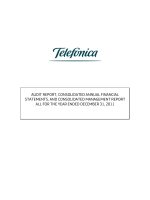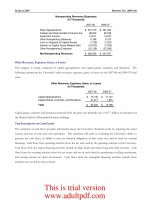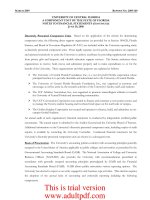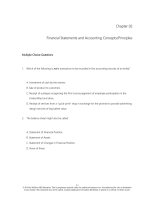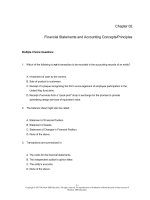Lecture Accounting: What the numbers mean (5/e) - Chapter 2: Financial statements and accounting concepts/principles
Bạn đang xem bản rút gọn của tài liệu. Xem và tải ngay bản đầy đủ của tài liệu tại đây (356.08 KB, 40 trang )
CHAPTER 2
FINANCIAL STATEMENTS AND
ACCOUNTING
CONCEPTS/PRINCIPLES
McGrawHill/Irwin
©The McGrawHill Companies, Inc., 2002
Learning Objectives
1. What are generally accepted
accounting principle?
2. What kind of information is reported
on each financial statement and
how are the financial statements
related?
3. What are transactions? What is the
meaning and usefulness of the
accounting equation?
4. What are meanings of the captions
in the financial statements?
McGrawHill/Irwin
©The McGrawHill Companies, Inc., 2002
Learning Objectives
5. Why is cash flow important?
6. What are the limitations of financial
statements?
7. What is an annual report and why
is it issued?
8. What are some of the business
practices related to organizations?
McGrawHill/Irwin
©The McGrawHill Companies, Inc., 2002
Learning Objective 1
•
McGrawHill/Irwin
What kind of information is
reported on each financial
statement and how are the
financial statements
related?
©The McGrawHill Companies, Inc., 2002
Financial Statements
•
Result of a process that begins with
an economic event
•
The event becomes a recorded
transaction
•
The transaction becomes part of a
firm’s financial statements
McGrawHill/Irwin
©The McGrawHill Companies, Inc., 2002
The Financial Statements
•
Balance Sheet – financial position at the
end of the period
•
Income Statement – earnings for the
period
•
Statement of Changes in Owners’ Equity
– investments by and distributions to
owners during the period
•
Statement of Cash Flows – cash flows
for the period
McGrawHill/Irwin
©The McGrawHill Companies, Inc., 2002
Process
Transactions
McGrawHill/Irwin
Procedures for sorting,
classifying, and
presenting (bookkeeping)
Selection of alternative
methods of reflecting the
effects of certain
transactions (accounting)
Financial
statements
©The McGrawHill Companies, Inc., 2002
Learning Objective 2
•
What are transactions? What
is the meaning and usefulness
of the accounting equation?
McGrawHill/Irwin
©The McGrawHill Companies, Inc., 2002
Transactions
•
Economic interchanges between
entities
• Examples are:
– A sale
– A purchase
– Receipts of cash by borrower
– Payment of cash by lender
McGrawHill/Irwin
©The McGrawHill Companies, Inc., 2002
Balance Sheet
• Financial position at the end of a period A snapshot at a point in time
• Also called Statement of Financial
Position
• Contains three parts:
– Assets
– Liabilities
– Owners’ Equity
• Assets = Liabilities + Owners’ Equity
McGrawHill/Irwin
©The McGrawHill Companies, Inc., 2002
Learning Objective 3
•
What are the meanings of
the captions in the financial
statements?
McGrawHill/Irwin
©The McGrawHill Companies, Inc., 2002
Assets
•
Probable future economic benefits
•
Resources owned
•
Can be classified as current or longterm
McGrawHill/Irwin
©The McGrawHill Companies, Inc., 2002
Examples of Assets
•
Cash – cash on hand or in banks
•
Accounts Receivable – amounts due from
customers
•
Merchandise Inventory – merchandise
acquired but not yet sold
•
Equipment – assets used in the business
•
Less: Accumulated Depreciation – cost of
equipment estimated to have been used up
McGrawHill/Irwin
©The McGrawHill Companies, Inc., 2002
Liabilities
•
Probable future sacrifices of economic
benefits
•
Obligations
•
Can be classified as current or long-term
McGrawHill/Irwin
©The McGrawHill Companies, Inc., 2002
Examples of Liabilities
•
Accounts Payable - amounts owed to
suppliers of merchandise inventory
•
Long-term Debt – amounts borrowed
but will not be repaid within one year
McGrawHill/Irwin
©The McGrawHill Companies, Inc., 2002
Income Statement
• Summary of the earnings for a
period
• Consists of:
– Revenues
– Expenses
• Covers a period of time
• Also called Statement of Earnings,
or Profit and Loss Statement, or
Statement of Operations
McGrawHill/Irwin
©The McGrawHill Companies, Inc., 2002
Income Statement Sections
•
Revenues - operating activities for the
period - often reported as Net Sales
•
Expenses - Costs incurred in
generating revenues
McGrawHill/Irwin
©The McGrawHill Companies, Inc., 2002
Examples of Expenses
•
•
•
•
Cost of Goods Sold – total cost of
inventory delivered to customers as a
result of sales
Selling, General, and Administrative
Expenses – operating expenses of an
entity
Interest Expense – cost of using
borrowed funds
Income Taxes
McGrawHill/Irwin
©The McGrawHill Companies, Inc., 2002
More Income Statement Sections
•
Gross Profit – difference between sales
and cost of goods sold
•
Income From Operations – an important
measure of a firm’s activities
•
Income Before Taxes – income
from operations less interest
expense
McGrawHill/Irwin
©The McGrawHill Companies, Inc., 2002
More Income Statement Sections
•
Net Income – income remaining after all
expenses have been deducted
•
Net Income Per Share of Common Stock
Outstanding – used in measuring the
market value of a share of common stock
McGrawHill/Irwin
©The McGrawHill Companies, Inc., 2002
Statement of Changes in
Owners’ Equity
•
Also called Statement of Changes in
Capital Stock, or Statement of Changes
in Retained Earnings
•
Explains the changes that occurred in
the components of owners’ equity
during the year
McGrawHill/Irwin
©The McGrawHill Companies, Inc., 2002
Owners’ Equity
• Paid-In Capital
– Common Stock - at par value
– Additional Paid-In Capital – difference
between total amount invested by the
owners and the par or stated value of the
stock
• Retained Earnings – cumulative net income
retained in the business
– Dividends – distribution of earnings to
owners
McGrawHill/Irwin
©The McGrawHill Companies, Inc., 2002
Learning Objective 5
•
Why is cash flow important?
McGrawHill/Irwin
©The McGrawHill Companies, Inc., 2002
Statement of Cash Flows
•
Sources and uses of cash
•
Covers a period of time
•
Includes:
– Operating Activities
– Investing Activities
– Financing Activities
McGrawHill/Irwin
©The McGrawHill Companies, Inc., 2002
Cash Flows from Operating
Activities
•
Start with Net Income
•
Add back Depreciation Expense
•
Deduct (add) increases (decreases) in
current assets
•
Deduct (add) decreases (increases) in
current liabilities
McGrawHill/Irwin
©The McGrawHill Companies, Inc., 2002
